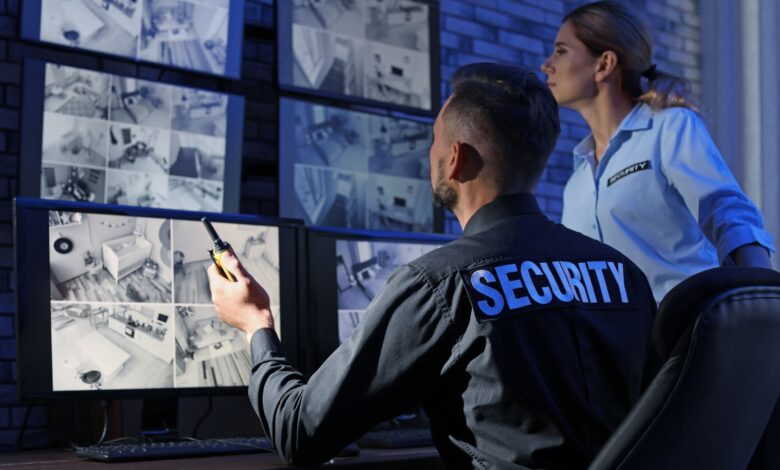What Can Remote Video Surveillance Do for You? 6 Top Security Services Explained

At a time when digital transformation and connectivity are rapidly reshaping the way we live, the approach to safety and security is also changing dramatically. The widespread adoption of remote video surveillance is one of the more revolutionary changes we’ve seen in recent years. But what exactly is this technology, and how can it improve your business security measures significantly?
What is Remote Video Surveillance?
Remote video surveillance is a sophisticated technology that captures and transmits live video feeds from a network of cameras to a Remote Security Operations Center (SOC), also known as a remote monitoring center. A team of trained security professionals responds diligently to alarms generated by the camera AI, verifying unusual or suspicious activity, and responding proactively to potential threats in accordance with the SOP. This hybrid of human expertise and cutting-edge technology provides 24-hour vigilance and real-time intervention, revolutionizing traditional security practices.
Let’s take a closer look at the top six security services made possible by remote video surveillance and see how much value they can provide to various industries.
1. Remote Video Monitoring
Remote video monitoring is the foundation of any remote video surveillance system. This service provides a comprehensive overview of your premises, identifies potential threats in real time, and implements rapid response measures using a combination of advanced AI algorithms and human oversight. When used properly, remote video monitoring can deter crime, prevent unauthorized access, and even aid in investigations. This makes it an invaluable tool in industries such as retail, logistics, manufacturing, truck yards, parking lots, car dealerships and construction, where large or multiple sites necessitate constant monitoring.
2. Virtual Guard Tours
Virtual Guard Tours bring the age-old concept of patrolling into the digital age. Rather than making physical rounds, a remote operator ‘tours’ the site using real-time video feeds from strategically placed cameras. Tours can be scheduled at regular intervals throughout the day or night. This method eliminates the possibility of missed areas and ensures complete coverage. Virtual guard tours can provide thorough and consistent vigilance to the education, hospitality, and real estate sectors, which deal with large campuses or vast areas.
3. Remote Concierge
The remote concierge service is where hospitality meets security. This service provides visitors, residents, or employees with assistance and information, like a traditional concierge, but from a remote location. From welcoming guests to answering queries, the remote concierge serves as the friendly face of your security system. This is particularly useful in settings like hotels, residential buildings, and corporate environments where customer service is as crucial as security. The remote concierge can grant or deny visitors access by using bidirectional audio and unidirectional video to validate individuals’ credentials or identity.
4. Remote Gate Control
Controlling who enters and exits a facility is often critical to its integrity. Remote Gate Control is an efficient way to manage access to your facility. It can grant access to authorized individuals, deny access to trespassers, and track all entries and exits from a remote location. This service is especially useful for gated communities, commercial buildings, truck yards, parking lots, and sensitive facilities that require strict access control to maintain security and order.
5. High-Value Cargo Monitoring
Industries involved in transporting high-value cargo, such as logistics, shipping, and valuable goods retail, face unique security challenges. High-Value Cargo Monitoring employs a combination of GPS tracking, real-time video surveillance, and other advanced technologies to oversee the entire journey of a shipment. This service can track routes, detect unauthorized access, and trigger preventive measures in case of attempted theft or mishandling, ensuring the cargo reaches its destination safely.
6. Uptime Monitoring
Finally, Uptime Monitoring is concerned with ensuring the operational integrity of a company’s digital infrastructure. It continuously monitors network systems, applications, and various aspects of a company’s technology infrastructure, quickly detecting system failures or downtime and enabling a quick response. Sectors such as IT, healthcare, governement buildings, and finance, where continuous service is essential, can benefit greatly from this digital watchdog.
To summarize, remote video surveillance and its suite of services offer a holistic approach to security. It’s not just about preventing theft or intrusion anymore; it’s about providing comprehensive safety solutions that cater to the unique needs of different industries. Each service under the remote video surveillance umbrella brings specific advantages to the table, enabling businesses to secure their premises and operations effectively. From large-scale manufacturing facilities to high-tech server rooms, from luxury hotels to academic campuses—there is a remote video surveillance solution that’s a perfect fit for your needs. Through this technology, you’re not just ensuring security; you’re securing peace of mind.
The Benefits of Remote Video Surveillance
Remote video surveillance is more than just a security measure at its core. It is a comprehensive, robust, and adaptable solution that provides numerous benefits to a variety of industries. The first significant advantage of remote video surveillance is the availability of round-the-clock monitoring. Regardless of time zones or shift schedules, a constant eye is kept on the premises, providing you with peace of mind 24 hours a day, seven days a week.
Another significant advantage is cost effectiveness. Traditional security solutions frequently necessitate a significant investment in human resources, such as security personnel salaries, training, and benefits. Remote video surveillance, on the other hand, can cover larger areas more effectively and often at a lower cost. Furthermore, it eliminates the possibility of human error, resulting in more dependable and consistent surveillance.
One of the more understated benefits of remote video surveillance is its deterrence factor. The visible presence of cameras can dissuade potential criminals, thereby preventing incidents before they even occur. When coupled with real-time monitoring, this can lead to quicker responses and timely intervention during security breaches, increasing the chances of apprehending perpetrators.
The adaptability of remote video surveillance adds to its power. Each system can be customized to meet the specific requirements of a location, such as tracking high-value cargo or providing a friendly face at the front desk. This level of customization ensures a more efficient security system that is tailored to your specific requirements.
Lastly, the data captured through surveillance cameras can be invaluable. In the event of a security incident, recorded footage can provide critical evidence that can assist in investigations and legal proceedings. Beyond this, video data can also provide insights into operational efficiencies, helping businesses streamline their processes and enhance productivity.
Finally, remote video surveillance provides numerous benefits such as round-the-clock security, cost savings, crime deterrence, customization, and valuable data capture. These advantages make it a powerful tool for any organization looking to improve its security and operational efficiency.



